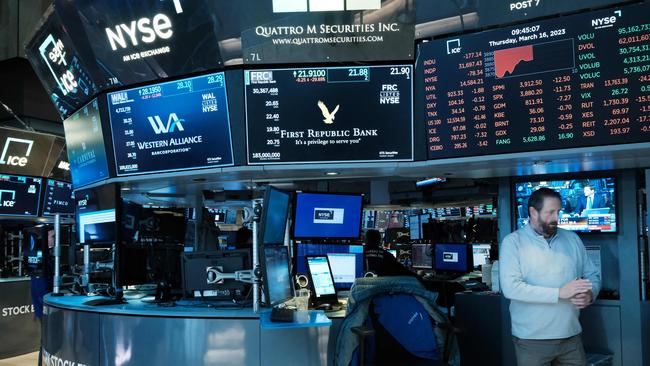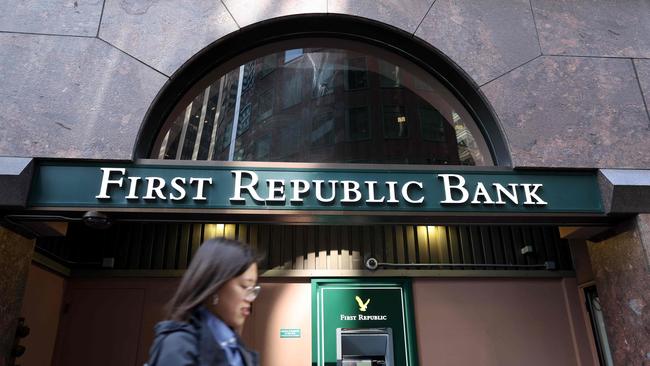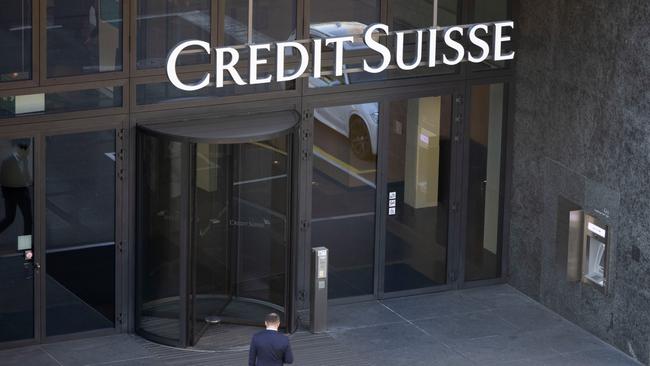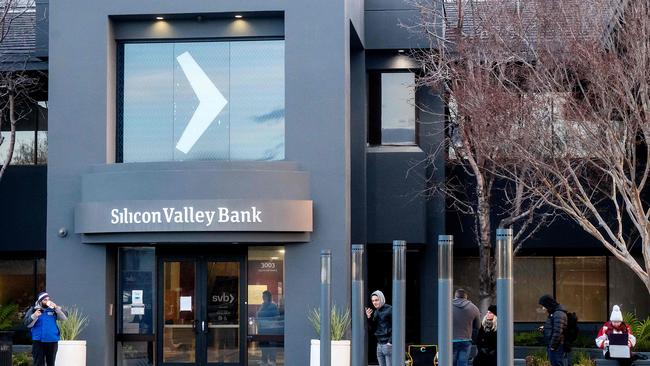What’s going on with First Republic Bank and Credit Suisse?
Banks across the US and Europe have seen billions wiped off their share price following the failure of Silicon Valley Bank. Why? And what comes next?

First Republic Bank shares have been hit hard over the past week following the failures of two large U.S. regional banks, Silicon Valley Bank and Signature Bank. On Thursday, shares of the bank and many other financial firms rallied after The Wall Street Journal reported that the biggest U.S. banks have agreed on a joint rescue of the San Francisco lender. Under the plan, 11 banks including JPMorgan Chase & Co. have placed $US30 billion in deposits at First Republic, using their own funds.

What happened to First Republic Bank?
First Republic was one of the banks to be swept up in the contagion that followed the March 10 failure of SVB Financial Corp., the parent of Silicon Valley Bank, because of some similarities including their size, their largely wealthy client base and the largely uninsured nature of their deposit bases.
Why does First Republic Bank need deposits?
Like many U.S. regional banks over the past week, First Republic has been facing worries that its depositors will leave, reflecting concerns revolving around its perceived similarity to Silicon Valley.
Silicon Valley Bank failed because the bank’s core business of lending to venture-capital firms and their startups was losing money, creating an ongoing cash need at the bank. But the firm had invested heavily in long-term bonds whose value was decimated by the Federal Reserve’s interest rate increases over the past year, meaning it could sell them only at a loss.
When Silicon Valley bank tried to raise cash anyway, its depositors -- who were largely business customers whose accounts were well above the $250,000 Federal Deposit Insurance Corp. limit -- fled for other banks. Uninsured depositors across the system took notice and First Republic, which had some two-thirds of its deposits in uninsured accounts, came under scrutiny.
How would this rescue of First Republic Bank work?
JPMorgan Chase & Co., Citigroup Inc., Bank of America Corp. and Wells Fargo & Co. are in talks to deposit $5 billion of their own money each into First Republic, the Journal reported, and a number of other large banks would all kick in smaller amounts. The move would in part seek to restore confidence in regional banks by showing the largest firms are willing to put their money to work there.
The situation is reminiscent of the drama in the banking system in the 2008 financial crisis, when JPMorgan played the role of white knight, purchasing Bear Stearns and then Washington Mutual.
“This show of support by a group of large banks is most welcome, and demonstrates the resilience of the banking system,” said a group of U.S. regulators led by Treasury Secretary Janet Yellen.
Are First Republic Bank’s problems over?
That isn’t clear. Shares rallied on Thursday afternoon but the scale of the rally narrowed somewhat as the afternoon played out, sug gesting there may be some doubts about whether the deal will happen or whether it will have the desired impact on broader depositor sentiment.
Other banking-sector problems remain potentially unresolved as well. Credit Suisse Group Inc. shares rallied in Zurich, a day after the Swiss giant agreed to borrow 50 billion Swiss francs ($53.7 billion) from the Swiss National Bank to ease its own crisis, but it isn’t clear whether greater unrest in Europe is at hand.
And top executives of First Republic Bank sold millions of dollars of company stock in the two months before the bank’s shares plummeted during the panic over the health of regional lenders, the Journal reported -- a fact that won’t sit well with many people regardless of how the rescue effort plays out.

Why Is Credit Suisse in trouble?
Stress in the U.S. banking system jumped across the Atlantic this week, sparking turmoil for embattled Swiss bank Credit Suisse.
The European lender has long been dogged by issues. But on Wednesday, problems surrounding the bank exploded into plain view. After a whirlwind 24 hours marked by a dramatic fall in the bank’s stock price and financial contagion concerns, the bank announced it would borrow cash from the Swiss central bank to shore up its liquidity.
Here’s what you need to know on how Credit Suisse got here and what might happen next.
First things first: What is Credit Suisse?
Zurich-based Credit Suisse [pronounced Credit Swees] traces its history back to 1856, when it was founded to finance the expansion of Swiss railroads. Today, it stands as Switzerland’s second-largest bank by assets, trailing UBS Group.
The bank’s main business is managing money and creating investment products for wealthy clients around the world. Recently, Credit Suisse has been working to spin off its investment-banking arm as part of an attempt to move on from a long stretch of scandals and quarterly losses.
What caused the crisis at Credit Suisse this week?
Investors have been on high alert for signs of contagion following the rapid collapse of California-based Silicon Valley Bank last week. That led to a selloff in shares of banks around the world, including Credit Suisse’s.
But problems for the Swiss lender turned particularly acute on Wednesday, when its largest shareholder, Saudi National Bank, said in a Bloomberg TV interview that it wasn’t considering adding to its investment due to regulatory rules. Saudi National Bank owns 9.9% of Credit Suisse. Capital requirements often prevent banks from holding more than 10% of other banks.
How did investors react to Saudi National Bank’s statement?
The timing couldn’t have been worse. Investors were already jittery about other potential weak links in the financial system. The comments amplified their concerns about the bank’s ability to make money and raised the prospect that it might have to tap shareholders again for funds.
So-called credit-default swaps surged, as investors rushed to protect themselves against a possible Credit Suisse default. At the same time, the Swiss lender’s shares plunged, losing 24% on Wednesday -- its largest-one day drop in recorded history. Prices on its bonds fell to distressed levels.
Traders rushed to scoop up options tied to Credit Suisse, with activity hitting its highest levels in recent history, according to data provider Trade Alert. Put options -- or bearish contracts that typically profit as a stock falls -- outnumbered bullish call options.
Credit Suisse clients and regulators were keeping close watch. European Central Bank officials called the banks it supervises to ask about their exposure to Credit Suisse, people familiar with the matter said. Meanwhile, some clients paused trades with the bank, The Wall Street Journal reported.

What happened after the market panic?
After the close of European markets on Wednesday, Swiss regulators said they would provide liquidity to Credit Suisse, if needed.
Within hours, Credit Suisse said it would tap a more than $50 billion lifeline from the Swiss National Bank. That sent Credit Suisse’s stock price up on Thursday, lifting other European banks alongside it.
Credit Suisse may not actually need the money, analysts said. Rather, it borrowed the money to reassure investors about their ability to get cash quickly.
Dan Davies, head of research at Frontline Analysts, said the bank likely won’t use the facility to cover operating costs. It has used the aid to buy liquid securities, which could be sold quickly if the bank ever needed the cash, improving its balance sheet, he said.
“They’ve mainly got that for the purposes of having it in order to wave it around and tell everyone, ‘Look at our strong liquidity ratio,’” he said.
It was likely intended as a show of force to investors who shorted Credit Suisse’s stock or sold credit-default swaps insuring against default, said Jérôme Legras, head of research at Axiom Alternative Investments.
How far back do Credit Suisse’s problems go?
For years.
The bank has weathered a period of market crises, executive turnover and financial losses. Most notably, it was burned by its connection to the separate collapses of now-bankrupt Greensill Capital and Bill Hwang’s Archegos Capital Management. In 2021, the Credit Suisse took a $5 billion hit due to the collapse of Archegos, which was equivalent to more than a year’s worth of profit.
More recently, the bank has been contending with customer withdrawals. In October, a social-media firestorm over the bank’s health drove outflows of rich clients, Credit Suisse executives have said.
The withdrawals continued through the end of the quarter and prompted the bank to reach out personally to more than 10,000 wealthy customers to reassure them of the bank’s health.
Deposits fell 40% last year to 234 billion Swiss francs, equivalent to $252 billion, while total assets dropped 30% to 531 billion francs, or about $571 billion, because the bank was, among other things, scaling back its businesses. Credit Suisse reported a 2022 net loss of 7.3 billion francs, after posting a net loss of 1.7 billion francs the year before.
Investors were already spooked by last year’s outflows. “Their investors and their deposit holders have been basically looking at this slightly on edge,” said Octavio Marenzi, chief executive of consulting firm Opimas.
Wealth management clients are extremely conservative investors with very large amounts of money and they became concerned, he said. “It’s been a slow motion unfolding with CS that reached a breaking point and tipping point a few days ago.”
How is Credit Suisse different from Silicon Valley Bank?
Credit Suisse mainly manages money for people with millions of dollars to invest. The bank counts billionaires and sovereign-wealth funds among its biggest clients. Most of its loan portfolio is in ultraconservative Switzerland, where it is the country’s No. 2 bank by assets, serving savers and companies. It also has large investment banking and asset management arms.
It is considered a systemically important bank by global regulators given its size and interconnectedness with the financial system.
Silicon Valley Bank was a regional bank, serving U.S. venture capitalists and technology startups.
Credit Suisse, as is typical in the industry, has placed bets to hedge against rising interest rates; Silicon Valley Bank reported virtually no interest rate hedges on its massive bond portfolio at the end of 2022.
What happens now?
JP Morgan analysts said Credit Suisse still faces market-confidence issues even if it doesn’t have a capital problem. The U.S. bank laid out three scenarios for the bank: -- The bank continues as a stand-alone lender, closing its investment-banking unit and raising equity through a partial initial public offering of its Swiss business. But it is unclear if Credit Suisse has time to go through with this plan. -- The Swiss National Bank steps in with a full deposit guarantee on all deposits, or injects money into Credit Suisse, though nowadays, tapping taxpayers may prove unacceptable. -- Another company takes over the bank, with Swiss rival UBS as a possible candidate. What implications do Credit Suisse’s troubles have on the global banking system?
Credit Suisse is deeply integrated into the global financial system -- working closely with a number of banks and institutional investors. European banking stocks tumbled this week due in part to investor fears of contagion, investors said.
On a broader level, the problems of Silicon Valley Bank and Credit Suisse have led investors to believe that the Federal Reserve might pause or scale back its plans to further raise interest rates to tame inflation.
The Wall Street Journal





To join the conversation, please log in. Don't have an account? Register
Join the conversation, you are commenting as Logout